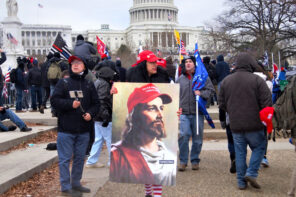Readers of RD don’t need to be told that the image of “The First Thanksgiving” that Americans carry around in their heads is mainly the product of 19th century romanticism: Longfellow with a dash of Disney. I want to argue here that the sanitized image is far from harmless and also that the granular history of colonial violence is important to grasp because it’s impossible to fully understand slavery without first understanding Indian displacement and enslavement.
Getting this right also gets rid of an unhelpful Original Sin framing for the nightmare of the Middle Passage. It takes nothing away from the horrors of the African slave trade to note how it was foregrounded by the white Christian settler colonialism that preceded it. The crimes are directly linked, and both contributed to the formation of white supremacy. The chattel slavery conducted at an unprecedented scale by the end of the 18th century was not an exceptional, albeit horrific, blot on an otherwise inspiring chronicle of white people’s New World thriving.
These days I live an hour away from Plymouth Rock, pathetic pebble that it is. There was to be a big public celebration of the Pilgrims’ arrival at said Rock this month, even though the Mayflower was actually stranded in Provincetown for several weeks after making landfall on Nov. 11, 1620.
Covid killed those plans this year, but we still need to brace for the arrival of next year’s indecent hordes. Indecent because when they come to celebrate the 400th anniversary of the First Thanksgiving (December 1621) they will help perpetuate a crucially important Founding Myth.
According to this powerful myth, still incredibly salient in right-wing media, the colonists’ Mayflower Compact sowed the seeds of democracy and religious freedom. Their final landing on good soil (the Mayflower first washed up in sandy Provincetown) marked God’s blessing upon the colonial enterprise. And their subsequent Thanksgiving feast signified goodwill on both sides—and thus what a shame that we couldn’t stay friends with the humble savages who helped us through that first brutal winter in the Little Ice Age.
It’s well past time for this Founding Myth to go. It’s time for white people to face up to a criminal history in all its fullness, which means starting with the earliest crimes. In this reckoning, we must take our cues from the clear leadership provided by Native American activists—leadership that goes back many decades but that’s finally gaining traction with a sharp focus on November’s misremembering.
Real history, then. We can start with 1614. That’s when Tisquantum, a.ka. Squanto, was kidnapped by an English raiding party and sold into slavery in Spain along with other captives. Buddies of marauding Captain John Smith did this deed. Note that slavery lies at the foundation—in this case enslavement of the original inhabitants. Squanto eventually made his way to England, learning English, before returning to home ground in 1619 and learning that his entire tribe had perished of a disease most likely spread by some of the same marauders who enslaved him. Having to fend for himself, Squanto threw in with the settlers in 1621, becoming a crucial intermediary between the so-called Pilgrims (they called themselves Separatists) and the surrounding tribes. Squanto thereby entered Thanksgiving lore as Good Indian #1.
“Come, Ye Thankful People, Come”: The primary problem with the sanitized Thanksgiving myth is how white celebrants never pause to consider what the colonists did, both before and after the peace that Squanto helped them forge with area sachems. Before they got to Plymouth, while they were still marooned way out on the Cape, they raided Native food stores and a child’s grave, helping themselves to “some of the best things” they found in Indian dwellings.
Later, and despite their official detente with the Wampanoags, they embarked on an unbroken rampage of expropriation and murder. Even pop historian Nathan Philbrick, who generally loves to throw a glowing halo over the exploits of white Americans, can’t escape telling the story of colonist treachery and aggression in his Mayflower tome (2006). Luring key warriors into a a bloody ambush under premise of peace (Miles Standish – 1623); fomenting inter-tribal warfare so as to advance the liquidation of the indigenes; burning the indigenes alive (e.g., at the Pequot massacre of 1637 – and we know from colonial records that a day of general thanksgiving was proclaimed in the wake of this deadly stroke); and always—always—taking possession of the land and displacing Native peoples who had no concept of private land ownership according to English law.
If you are looking for Original Sin, here is where to look. The accurate term for that sin is settler colonialism. How it works is that white people show up and begin at once to chart, mark, divide, sell, enclose, and defend their private ownership—in a pattern still persisting today.
First came the expropriation and clearing of the land, then came the deployment of enslaved people—Native people first, then Africans—to work that land and covert it into white wealth and additional white power.*
A land haunted by history
During a recent burst of Indian Summer weather in New England, I spent a few days exploring nooks and crannies in what Rhode Islanders call South County: the broad sweep of glaciated land running westward from lower Narragansett Bay to Stonington, CT. Much of it remains rich alluvial farmland. This was the ancestral home of the powerful Narragansett tribe that had accepted the presence of Roger Williams and his little settlement at the head of the Bay.
Rhode Island people take great pride in the fact that Williams insisted that Indians were the white man’s equals in the eyes of God. That he learned their language and translated it. That he traded fairly with them at an outpost he established in Wickford. But they forget that when the chips were down during King Philip’s War, Williams couldn’t keep his own Puritan persecutors in Massachusetts and Connecticut from combining forces, sweeping in, and slaughtering a large encampment of officially neutral Narragansetts in Rhode Island’s Great Swamp.
The heavily armed raiders—and here is where the word “ranger” first comes into popular use to describe state-sanctioned guerrilla warfare—burned hundreds of wigwams, killed at least 700 Indians, and took hundreds of captives, whom they sold into slavery in the Antilles. Regrouping, the Narragansett warriors set about torching English settlements all along the western side of the Bay. When they got to Providence, Roger Williams pleaded and cajoled in a last-ditch effort to save his town. He was told to his face that no Englishman’s word could ever again be trusted after the unprovoked massacre of women and children at their encampment. Providence was not spared. It was burned to the ground in March of 1676.
The colonists soon rallied and “won” the bloody war. They celebrated by sending many of their Indian captives, including King Philip’s wife and son, into slavery in Bermuda. Once again, we see slavery lying at the foundation of the white project.
In those early days slavery’s epicenter was the Caribbean and Brazil; North America was peripheral. For at least a century following the introduction in 1640 of a Dutch technique for processing cane, England’s most valuable New World colonies were by far its sugar islands. The enslaved people who cut the cane and converted it into sugar and molasses died of horrific abuse in staggering numbers. These islands were perpetually hungry for more flesh. New arrivals, coming from North America in chains, were always welcome, and the grandee planters paid handsomely.
But routinely selling captured natives to the islands was just the beginning for the North American settlers. The long-lived Roger Williams was barely in his grave before his Rhode Island colony was already realizing the fabulous fortunes to be made in the Triangle Trade, and the rich land still occupied by the remaining Narragansetts proved to be perfect for the cultivation of foodstuffs, meat, and timber to supply the main sugar islands: Barbados, Jamaica, and Antigua.
What Rhode Islanders got in return for these essential deliveries was shiploads of molasses for the distilling of rum in prodigious amounts—rum that then went to Africa as currency for the purchase of slaves. In this way the export of essential goods from stolen Narragansett lands to the cruelest slave drivers on the planet, and the subsequent shipment of rum to Africa in return for slaves, formed the foundation of Rhode Island’s considerable early wealth.
It is anything but easy to get contemporary white Rhode Islanders to accept this tiny state’s outsized role in the business of African enslavement, let alone Indian enslavement. They don’t enjoy looking backward. They would rather tell you how proud they are that the state’s voters just decided to drop the awkward “…and Providence Plantations” from the state’s official name. Because there were never plantations here, and the name was confusing, they like to say. Except that there were plantations here.
Who did the heavy work in South County—on Narragansett land—growing the wheat and maize, minding the cattle, felling and hewing the timber, and building all those beautiful dry stone walls that still mark the land? Enslaved indigenous people and enslaved African people did that work. You can change a name, if you wish, but you can’t shake off the long shadow of a bloody and brutal history of
theft and violence.
Wheat and tares together sown
Why isn’t this history more widely known? Blame bad religion. Bad religion lies at the heart of the Thanksgiving myth because of the ease with which Christian colonists—and here not only the English but also the Dutch, Spanish, and Portuguese colonists—deployed the idea of divine blessing in support of their conquests. Absolutely essential to the acquisitive white project is the need to appear innocent at all times. And there’s nothing better for claiming innocence than being able to discern a providential hand hovering high above your own pillaging hands.
No European colonists did this rationalization better serve than the English Protestants, with their sense of themselves as a chosen New Israel. Cotton Mather’s monumental Magnalia Christi Americana is only the most famous among a plethora of “memorials” in English celebrating the role of God’s mighty hand in the white settlement of North America. One Mayflower passenger recorded his conviction that the open land surrounding Plymouth—land that had in fact been cleared in 1616 by Indians who were subsequently wiped out by a European-borne plague—clearly signaled God’s benevolent intention toward the English settlement.
I am harping especially hard on the Pious Pilgrim legend because it has such huge resonance, even now, in white liberal culture. And I am harping on it because I was seduced by the legend, and I repent myself today for letting myself get sucked in.
Two decades ago I was knocked out by Kevin Phillips’ The Cousins’ War, in which Phillips draws out common themes and common threads among the English Civil War, the American Revolution, and our own Civil War. The “good guys” throughout are all Pilgrims, so to speak: doughty English revolutionaries—religious Dissenters, close spiritual kin to the New England Separatists—fueled to fight King Charles by determination to worship their own way; their direct descendants scoring another smashing victory against a despotic George III to found the Virtuous Republic; and finally still more Yankee Congregationalists fighting a noble fight against the awful Bourbon slavers, themselves descended spiritually from the Anglican cavaliers who took the Crown’s side against Cromwell’s roundheads.
This chronicle-cum-legend is seductive and still resonant because it flatters white intellectuals who imagine themselves to be legatees of this great enlightened tradition: from Bradford and Winthrop and Williams to the revolutionary Adamses and Roger Sherman, and then on to Emerson and Channing and Horace Mann and Margaret Fuller and Charles Sumner and the Oliver Wendell Holmeses. The Best and Brightest with their Harvard and Yale pedigrees, keeping the flame of conscience and freedom alive in the face of ignorance and evil.
Today the most formidable exponent and curator of the Noble New England legacy is Marilynne Robinson, who writes ceaselessly—and powerfully, let it be said—about the gifts showered upon us by high-minded New England Protestants. As much as I admire and respect Robinson, I fear that the legacy of New England Protestantism is far more problematic than she suspects.
Yes, the New Englanders eventually fought the Southern slave masters but not until after two centuries of profiting from the business of slavery. Yes, the Yankees came to abhor slavery but they also abhorred—and persecuted—the free people of color in their midst. Yes, they spoke out against the annexation of Texas and the Mexican War, but not until after they had successfully executed their own project of land theft and empire building. And in terms of lasting damage done, the very scholarship that Robinson valorizes—that Yankee compulsion to forge a narrative and make meaning from it—is primarily responsible for creating the most essential adjunct to white domination: the notion of the Virtuous Republic.
Robinson is not alone in ignoring a central problem in the New England inheritance. We might call this the “wheat and tares” problem and look to the telling second verse of “Come, Ye Thankful People, Come”—the hymn that normally would be sung in tens of thousands of Christian churches at Thanksgiving time (and that will still be sung in many churches this year, Covid be damned):
Wheat and tares together sown,
Unto joy or sorrow grown.
First the blade, and then the ear,
Then the full corn shall appear.
Lord of harvest, grant that we
Wholesome grain and pure may be.
The hymn is perfectly attuned to an old school Calvinist sensibility: to wit, I don’t know about you, but I hope to be one of the good seeds, one of the predestined ones grown into wholesome grain fit for the harvest. How this overarching religious sensibility contributes to white people’s extreme individualism, arrogance, and demonization/exclusion of the Other is not immediately obvious, which is why the religious roots of a unique American madness remain more obscure than they should.
Why this matters, one more time, is that extreme individualism and exclusion of the Other are not the natural way of human being. It is a peculiarly white European expression of pathology, a pathology reaching its maximum strength via our warped version of Calvinism. Among the people coming for the first time to think of themselves as “white” in the 17th century, a growing sense of personal sovereignty easily passes over into a strong sense of the right to dominate, both individually and collectively, and to use violence in the exercise of that right.
Side note of significance: We like to think that contemporary America is governed by popular sovereignty, but that’s not even remotely accurate. And here I’m not talking about the Electoral College. Americans’ obsession with gun rights; their resistance to Covid restrictions; the prevalence and resonance of the castle doctrine; the rapid growth of anti-vaxxing ideology among liberal elites; not to mention a broader and rapidly metastasizing libertarianism: all point to the reality that in a culture still suffused with a twisted Calvinism, it’s personal sovereignty that matters most. There’s a rich irony in this, of course, in that in John Calvin’s original formulation, God alone is sovereign. But this is a confusion that cannot be undone. And if we aspire to achieve a normal country anytime soon, we need to start talking about the scary atomism that our peculiar notion of personal sovereignty has saddled us with.
Anti-Blackness in context
Back now to the importance of historical accuracy. Nothing in the foregoing discussion of settler colonial violence diminishes the vileness of anti-Black racism or the horrors of the Middle Passage. But it helps us to comprehend this vileness in the context of the comprehensive pathology of the White Way of Thinking and the White Way of Being, in which domination and violence naturally flow from an assumption of original innocence and an incredible facility in manipulating a self-serving religion to reinforce that sense of innocence.
It remains incontestable that the lurch into total national dependence on an exceptionally cruel form of chattel slavery came quickly to white people in North America in both the South and the North. In a very real sense, the brutal slavery practiced in the islands migrated to the mainland, with South Carolina functioning as an extension of Barbados during the late 17th century. White colonists everywhere marveled at the strength and endurance of kidnapped Africans subjected to the most extreme conditions.
But we must be clear that the buying and selling and torturing of people of African descent was not the original sin. The original sin (lower case) was the assumption by white settlers of a God-given right to take possession of all they surveyed—a right to exercise complete dominion, using any amount of violence to achieve it.
And for all their claims to have launched a better and higher mission in Plymouth than those indolent Anglican settlers in Jamestown could even imagine, the New Englanders were always all about their pelf and plunder. And the best part? Making it appear to be all about God’s plan. It’s this piece of prestidigitation that makes the year 1620 worthy of being remembered as Year Zero in the formation of a death-dealing American Way.
*If confirmation of this sequence is needed, I recommend three solid histories about how the epic crime spree unfolded: Gerald Horne’s The Apocalypse of Settler Colonialism, Roxanne Dunbar-Ortiz’s An Indigenous People’s History of the United States, and Claudio Saunt’s Unworthy Republic. Read even one of these and you will never again buy into the Founding Myth.





